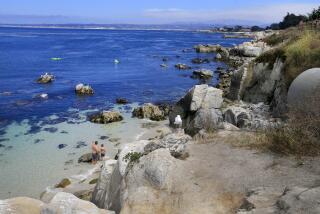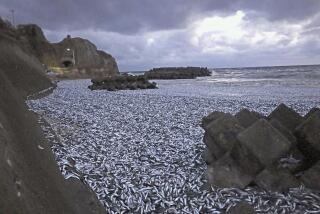Japan’s Rising Tide of Coral Defenders
- Share via
ISHIGAKI, Japan — The economy here on Ishigaki Island is desperately dependent on the divers and snorkelers who flock to its shores for the vivid coral reef, which teems with a dizzying array of strikingly colored fish and giant manta rays that look like bat-shaped spaceships.
To accommodate the growing throngs of visitors descending on this island in southernmost Japan, not far from Taiwan, government officials are planning a $440-million airport to replace the dingy, cramped facility on the island’s edge.
But fishermen, divers and environmentalists say Ishigaki, and in fact all the islands that make up the Okinawa chain, may be striking a Faustian bargain. The islands temporarily shore up their economies with public works projects because they have little other industry. But the projects may imperil the environment, the islands’ main attraction.
“It’s something like cocaine--they can’t stop” taking the aid projects, said Kunitoshi Sakurai, an international communications professor at the University of Okinawa who directs an environmental coalition with 900 members.
One particularly controversial project: the relocation within Okinawa, the chain’s main island, of a U.S. military heliport. Environmentalists contend that the proposed move will not only destroy the coral reef near the site but endanger a population of dugongs, a sea mammal related to the manatee.
The construction projects--including about $2.9 billion for public works projects on Okinawa from the central government this year--often trigger a soil runoff that environmentalists say is destroying the coral reef.
“When it rains, the sea bleeds red soil,” Sakurai said.
Ishigaki fisherman Morihiro Nakada sees it most days when he pulls up his circular nets, which are saturated with the orange mud. When it rains, especially during monsoons, the soil runoff can transform the ordinarily translucent water into a red sea for as far as half a mile out.
The runoff has contributed to the destruction of at least 50% of the coral around Ishigaki, fishermen and environmentalists say, with some estimates as high as 70%. (Other factors, including global warming and pollution, are believed to have contributed to the coral’s decline here and throughout the world.)
Kohei Okada, who is in charge of land development projects on Okinawa, said the government doesn’t have any measures to protect coral and has only recently begun researching the problem.
“Of course we care about preventing damage to the coral and subtropical plants and fish, including seaweed,” he said. The government advises the construction contractors to plant trees and cover dirt piles with dried hay to secure the soil, he said.
In a moment of unity, about 50 dive shop owners banded together with fishermen--with whom they usually squabble over sea-use rights--to pursue a common goal: preservation of the coral.
They are lobbying for the public works spending to be redirected into environmental preservation. Group leader and dive shop owner Nobuo Saeki, who moved to Ishigaki 27 years ago from northern Japan, said: “There’s been 20 years of damage to the coral reef. It will take another 20 years to repair it.
“I want to fight for this because this environment made me think I want to live here forever. Every time I go down, I see new things.”
*
Rie Sasaki of The Times’ Tokyo Bureau contributed to this report.
More to Read
Sign up for Essential California
The most important California stories and recommendations in your inbox every morning.
You may occasionally receive promotional content from the Los Angeles Times.










